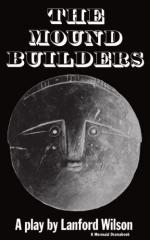are singularly deficient, just as it is with greatest
difficulty that they can be induced even on a small
scale to practice agriculture. It has been objected
to this conclusion that the Indians can make a canoe,
which is a marvel in its way. But there is a
great difference in the two cases. In the canoe
all the materials remain the same. The approximation
to a chemical process makes the pottery manufacture
a much more complicated matter. Indeed the Indian
in token of his surprise at his success in being even
able to construct a canoe, states in his tradition
that it is the gift of the Manitou. Furthermore
the mound builder used metal tools, and was probably
a metal worker. It is true the copper implements
mentioned, as having been found were brought to Rainy
and Red Rivers. I have, however, pointed out
the intimate connection judging by the line of transport
subsisting between Rainy River and Lake Superior, the
mining locality for copper. To sink a mine in
the unyielding Huronian rock of Lake Superior, with
mallet and hammer and wedge and fire, take out the
native copper, work it into the desired tools, and
then temper these requires skill and adaptation unpossessed
by the Indians. For centuries we know that the
Lake Superior mine in which are found tools and timber
constructions, have been buried, filled in for ten
feet with debris, and have rank vegetation and trees
growing upon them. It is certain that the Indian
races, even when shown the example, cannot when left
alone follow the mining pursuit. Not only then
by the ethnological, and other data cited do we conclude
that the mound builders belong to a different race
from the present Indians, but the tradition of the
Indians is to the same effect. Then
WHO WERE THE MOUND BUILDERS?
I would lead you back now to what little we know from
the different sources, of the early history of our
continent. When the Spaniards came to Mexico
in the early years of the 16th century, Montezuma,
an Aztec prince was on the throne. The Aztecs
gave themselves out as intruders in Mexico. They
were a bloody and warlike race, and though they gave
the Spaniards an easy victory it was rather a reception,
for they were overawed by superstition as to the invaders.
They stated that a few centuries before, they had
been a wild tribe on the high country of the Rio Grande
and Colorado, in New Mexico. The access from
the Pacific up the Colorado would agree well with the
hypothesis that the chief sources of the aboriginal
inhabitants of America were Mongolian, and that from
parties of Mongols landing from the Pacific Isles
on the American coast, the population was derived.
At any rate the Aztecs stated that before they invaded
Mexico from their original home, they were preceded
by a civilized race, well acquainted with the arts
and science, knowing more art and astronomy in particular
than they. They stated that they had exterminated
this race known as
THE TOLTECS.




